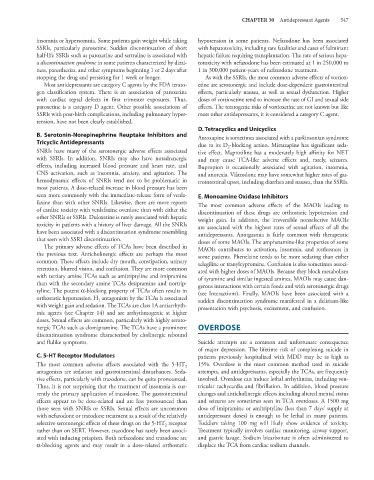Page 561 - Basic _ Clinical Pharmacology ( PDFDrive )
P. 561
CHAPTER 30 Antidepressant Agents 547
insomnia or hypersomnia. Some patients gain weight while taking hypotension in some patients. Nefazodone has been associated
SSRIs, particularly paroxetine. Sudden discontinuation of short with hepatotoxicity, including rare fatalities and cases of fulminant
half-life SSRIs such as paroxetine and sertraline is associated with hepatic failure requiring transplantation. The rate of serious hepa-
a discontinuation syndrome in some patients characterized by dizzi- totoxicity with nefazodone has been estimated at 1 in 250,000 to
ness, paresthesias, and other symptoms beginning 1 or 2 days after 1 in 300,000 patient-years of nefazodone treatment.
stopping the drug and persisting for 1 week or longer. As with the SSRIs, the most common adverse effects of vortiox-
Most antidepressants are category C agents by the FDA terato- etine are serotonergic and include dose-dependent gastrointestinal
gen classification system. There is an association of paroxetine effects, particularly nausea, as well as sexual dysfunction. Higher
with cardiac septal defects in first trimester exposures. Thus, doses of vortioxetine tend to increase the rate of GI and sexual side
paroxetine is a category D agent. Other possible associations of effects. The teratogenic risks of vortioxetine are not known but like
SSRIs with post-birth complications, including pulmonary hyper- most other antidepressants, it is considered a category C agent.
tension, have not been clearly established.
D. Tetracyclics and Unicyclics
B. Serotonin-Norepinephrine Reuptake Inhibitors and Amoxapine is sometimes associated with a parkinsonian syndrome
Tricyclic Antidepressants due to its D -blocking action. Mirtazapine has significant seda-
2
SNRIs have many of the serotonergic adverse effects associated tive effect. Maprotiline has a moderately high affinity for NET
with SSRIs. In addition, SNRIs may also have noradrenergic and may cause TCA-like adverse effects and, rarely, seizures.
effects, including increased blood pressure and heart rate, and Bupropion is occasionally associated with agitation, insomnia,
CNS activation, such as insomnia, anxiety, and agitation. The and anorexia. Vilazodone may have somewhat higher rates of gas-
hemodynamic effects of SNRIs tend not to be problematic in trointestinal upset, including diarrhea and nausea, than the SSRIs.
most patients. A dose-related increase in blood pressure has been
seen more commonly with the immediate-release form of venla- E. Monoamine Oxidase Inhibitors
faxine than with other SNRIs. Likewise, there are more reports The most common adverse effects of the MAOIs leading to
of cardiac toxicity with venlafaxine overdose than with either the discontinuation of these drugs are orthostatic hypotension and
other SNRIs or SSRIs. Duloxetine is rarely associated with hepatic weight gain. In addition, the irreversible nonselective MAOIs
toxicity in patients with a history of liver damage. All the SNRIs are associated with the highest rates of sexual effects of all the
have been associated with a discontinuation syndrome resembling antidepressants. Anorgasmia is fairly common with therapeutic
that seen with SSRI discontinuation. doses of some MAOIs. The amphetamine-like properties of some
The primary adverse effects of TCAs have been described in MAOIs contributes to activation, insomnia, and restlessness in
the previous text. Anticholinergic effects are perhaps the most some patients. Phenelzine tends to be more sedating than either
common. These effects include dry mouth, constipation, urinary selegiline or tranylcypromine. Confusion is also sometimes associ-
retention, blurred vision, and confusion. They are more common ated with higher doses of MAOIs. Because they block metabolism
with tertiary amine TCAs such as amitriptyline and imipramine of tyramine and similar ingested amines, MAOIs may cause dan-
than with the secondary amine TCAs desipramine and nortrip- gerous interactions with certain foods and with serotonergic drugs
tyline. The potent α-blocking property of TCAs often results in (see Interactions). Finally, MAOIs have been associated with a
orthostatic hypotension. H antagonism by the TCAs is associated sudden discontinuation syndrome manifested in a delirium-like
1
with weight gain and sedation. The TCAs are class 1A antiarrhyth- presentation with psychosis, excitement, and confusion.
mic agents (see Chapter 14) and are arrhythmogenic at higher
doses. Sexual effects are common, particularly with highly seroto-
nergic TCAs such as clomipramine. The TCAs have a prominent OVERDOSE
discontinuation syndrome characterized by cholinergic rebound
and flulike symptoms. Suicide attempts are a common and unfortunate consequence
of major depression. The lifetime risk of completing suicide in
C. 5-HT Receptor Modulators patients previously hospitalized with MDD may be as high as
The most common adverse effects associated with the 5-HT 15%. Overdose is the most common method used in suicide
2
antagonists are sedation and gastrointestinal disturbances. Seda- attempts, and antidepressants, especially the TCAs, are frequently
tive effects, particularly with trazodone, can be quite pronounced. involved. Overdose can induce lethal arrhythmias, including ven-
Thus, it is not surprising that the treatment of insomnia is cur- tricular tachycardia and fibrillation. In addition, blood pressure
rently the primary application of trazodone. The gastrointestinal changes and anticholinergic effects including altered mental status
effects appear to be dose-related and are less pronounced than and seizures are sometimes seen in TCA overdoses. A 1500 mg
those seen with SNRIs or SSRIs. Sexual effects are uncommon dose of imipramine or amitriptyline (less than 7 days’ supply at
with nefazodone or trazodone treatment as a result of the relatively antidepressant doses) is enough to be lethal in many patients.
selective serotonergic effects of these drugs on the 5-HT receptor Toddlers taking 100 mg will likely show evidence of toxicity.
2
rather than on SERT. However, trazodone has rarely been associ- Treatment typically involves cardiac monitoring, airway support,
ated with inducing priapism. Both nefazodone and trazodone are and gastric lavage. Sodium bicarbonate is often administered to
α-blocking agents and may result in a dose-related orthostatic displace the TCA from cardiac sodium channels.

